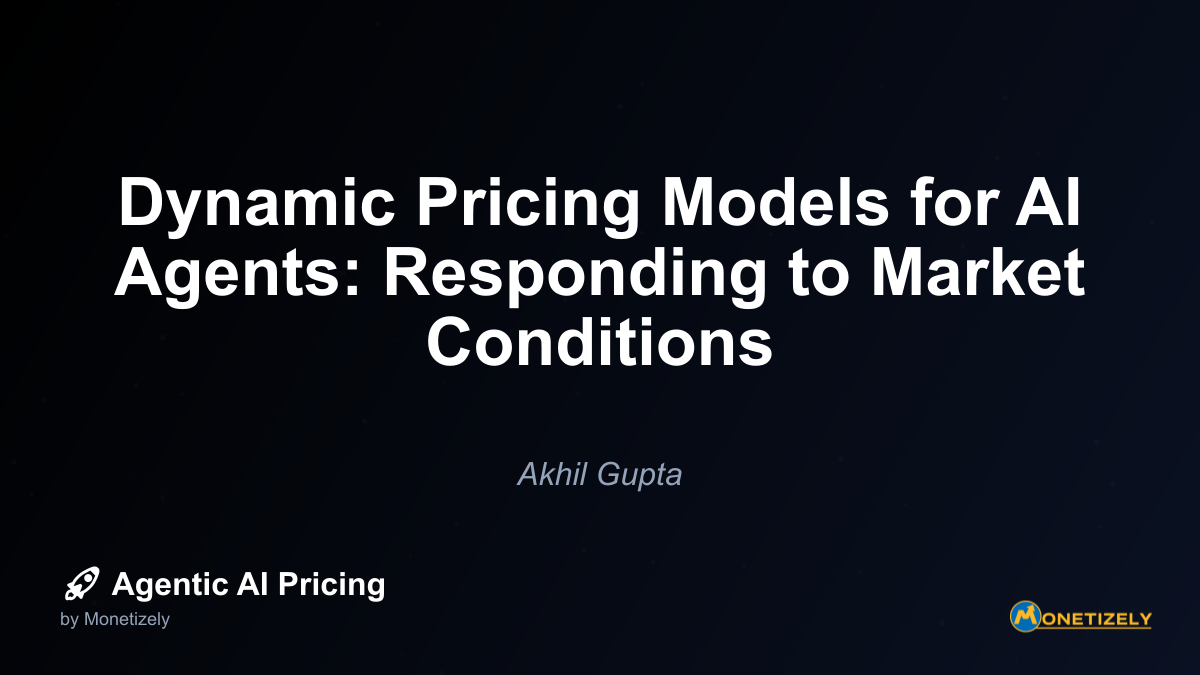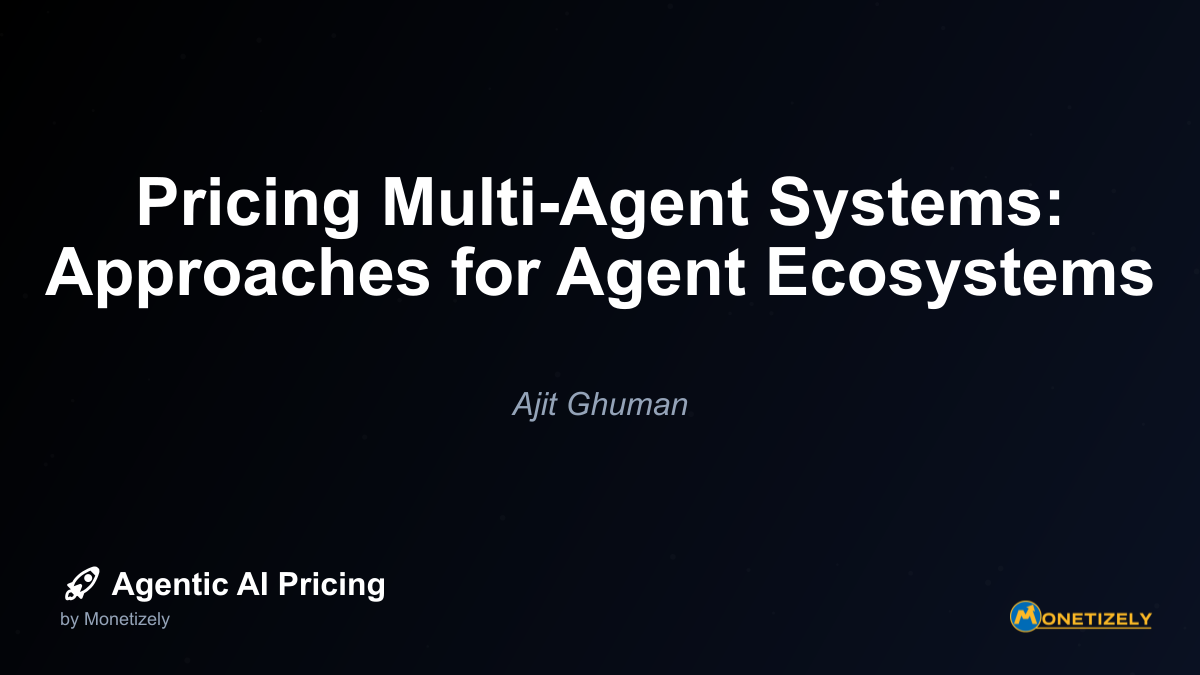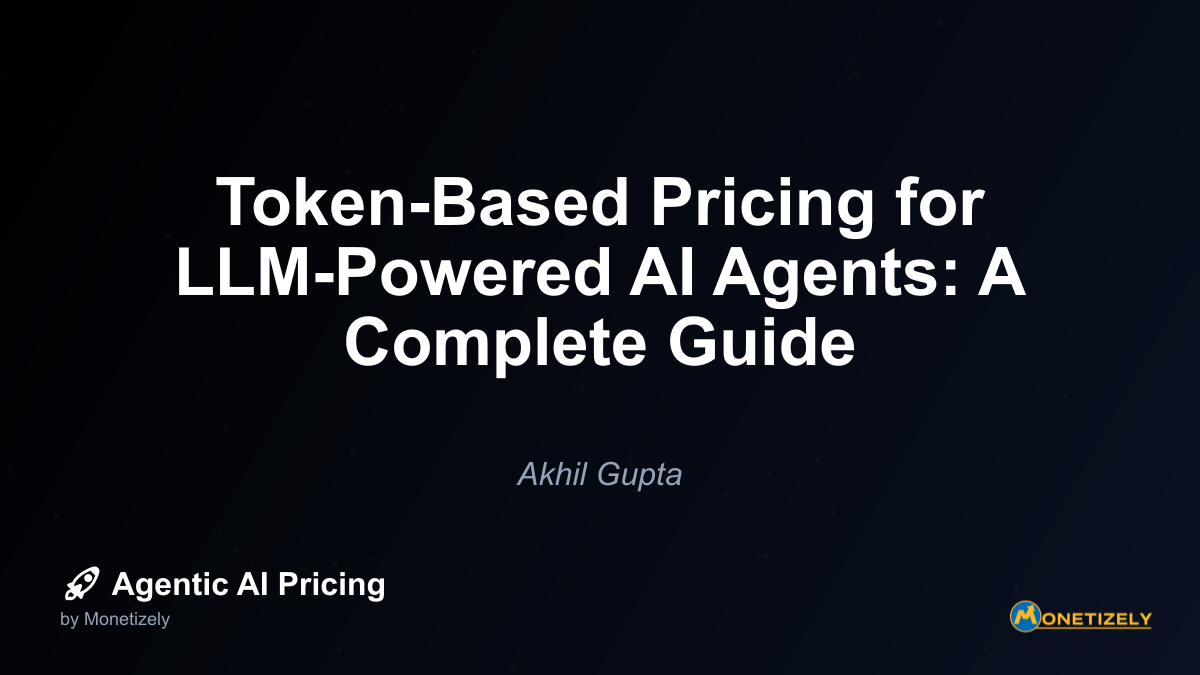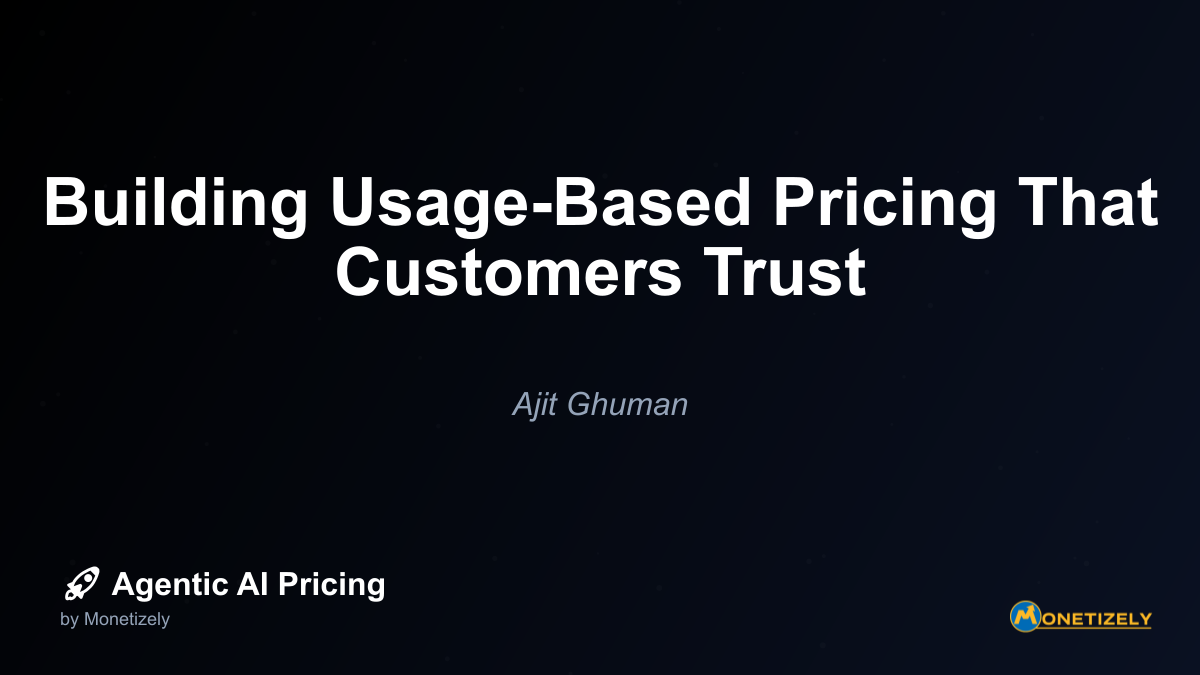· Akhil Gupta · AI Pricing Models · 12 min read
Pricing Models for Edge-Deployed vs. Cloud AI Agents
AI and SaaS Pricing Masterclass
Learn the art of strategic pricing directly from industry experts. Our comprehensive course provides frameworks and methodologies for optimizing your pricing strategy in the evolving AI landscape. Earn a professional certification that can be imported directly to your LinkedIn profile.
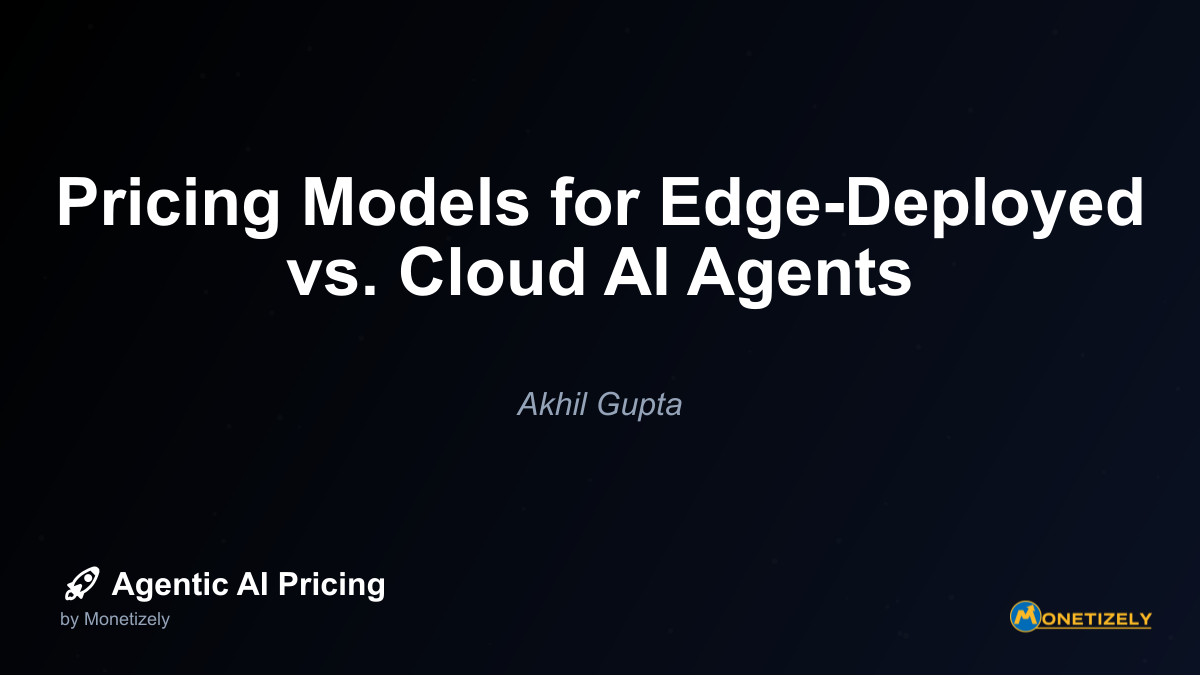
In today’s rapidly evolving AI landscape, the choice between edge-deployed and cloud-based AI agents represents more than just a technical decision—it fundamentally shapes how these solutions are monetized, priced, and ultimately valued by the market. As organizations increasingly integrate AI capabilities into their core operations, understanding the nuanced pricing models for these different deployment environments has become critical for both vendors and buyers.
Edge AI and cloud AI represent two distinct approaches to deploying artificial intelligence solutions, each with unique cost structures, performance characteristics, and value propositions. This comprehensive analysis examines how these deployment environments influence pricing models, exploring the strategic considerations that executives and pricing professionals must navigate when monetizing AI solutions.
The Fundamental Distinction: Edge vs. Cloud Deployment
Before diving into pricing models, it’s essential to understand the core differences between edge and cloud AI deployments and how they shape monetization strategies.
Edge AI: Intelligence at the Source
Edge AI refers to AI algorithms processed locally on a device—smartphones, IoT sensors, industrial equipment, or specialized edge computing hardware—rather than in a centralized cloud environment. This approach brings computation directly to where data is generated, enabling:
- Real-time processing with ultra-low latency (often < 100ms)
- Offline operation without continuous internet connectivity
- Enhanced privacy by keeping sensitive data local
- Reduced bandwidth usage by eliminating constant data transfer
Cloud AI: Centralized Computing Power
Cloud AI leverages remote server infrastructure to process AI workloads, offering:
- Virtually unlimited computational resources on demand
- Centralized management and easier deployment
- Simplified scaling without hardware constraints
- Access to more powerful models that may exceed local device capabilities
Cost Structure Differences Driving Pricing Models
The fundamental economics of edge and cloud AI differ significantly, directly influencing how vendors structure their pricing models.
Cloud AI Cost Structure
Cloud AI solutions typically feature:
- Low initial investment with minimal upfront costs
- Ongoing operational expenses based on usage
- Linear scaling costs that increase with consumption
- Bandwidth and data transfer expenses
- Predictable subscription or consumption-based pricing
Edge AI Cost Structure
Edge solutions present a different economic profile:
- Higher upfront hardware investment for edge devices/infrastructure
- Device deployment and maintenance costs
- Lower ongoing operational expenses after deployment
- Minimal bandwidth and data transfer costs
- Hardware refresh cycles affecting long-term economics
Dominant Pricing Models for Cloud AI Solutions
Cloud AI vendors have established several pricing approaches that reflect the service-oriented nature of their offerings.
1. Consumption-Based Pricing
The most common cloud AI pricing model charges customers based on actual usage metrics:
- Per API call (e.g., $0.0001-0.01 per API request)
- Per token/word processed (e.g., OpenAI’s GPT models charging per 1,000 tokens)
- Per inference (charging for each prediction made)
- Per minute/hour of compute time (especially for training workloads)
This approach aligns costs directly with value received, allowing customers to scale expenses with usage. According to recent market analysis, consumption-based pricing dominates approximately 68% of cloud AI offerings, with most major providers including AWS, Google Cloud, and Microsoft Azure employing this model for their AI services.
2. Tiered Subscription Models
Many cloud AI providers offer tiered subscription plans that bundle certain usage volumes:
- Free tier with limited functionality or usage caps
- Standard tier for small to medium businesses
- Enterprise tier with higher limits and additional features
- Custom tier for organizations with specialized needs
These tiers typically include monthly or annual commitments with preset usage allowances, providing more predictable costs for customers while ensuring recurring revenue for vendors. This model works particularly well for applications with relatively stable usage patterns.
3. Outcome-Based Pricing
A growing trend in cloud AI pricing ties costs directly to business outcomes:
- Success-based fees (e.g., charging per successful customer interaction)
- Performance-based pricing (fees vary based on accuracy or quality metrics)
- Revenue-sharing models (vendor receives percentage of value created)
This approach aligns vendor and customer incentives by directly connecting pricing to value creation. For example, a cloud-based customer service AI might charge per successful ticket resolution rather than per API call, creating a more transparent value proposition.
Emerging Pricing Models for Edge AI Solutions
Edge AI presents unique monetization challenges and opportunities, leading to several specialized pricing approaches.
1. Hardware-Software Bundling
Many edge AI solutions combine specialized hardware with pre-loaded AI capabilities:
- One-time purchase of edge devices with embedded AI functionality
- Tiered hardware pricing based on processing capability
- Hardware-as-a-Service models with regular refreshes
- Bundled solutions including hardware, software, and initial setup
This approach simplifies purchasing decisions by packaging the complete solution, though it creates challenges in communicating the value of the AI component specifically.
2. Perpetual Licensing with Maintenance
Some edge AI providers separate hardware from software licensing:
- Upfront license fee for AI software
- Annual maintenance contracts for updates and support
- Capacity-based licensing tied to processing volume or device count
- Feature-based tiers unlocking additional capabilities
This model resembles traditional enterprise software licensing but adapts to the distributed nature of edge deployments.
3. Hybrid Edge-Cloud Models
Increasingly popular are hybrid approaches that combine edge processing with cloud components:
- Base fee for edge deployment plus usage-based charges for cloud components
- Data volume tiers for information sent to the cloud
- Edge-cloud balancing options allowing customers to optimize cost vs. performance
- Pay-per-update for model refreshes pushed from cloud to edge
These models acknowledge that many AI systems benefit from both edge and cloud elements working in concert, with pricing reflecting this hybrid reality.
Industry-Specific Pricing Considerations
Pricing strategies for edge and cloud AI vary significantly across industries based on specific requirements and value propositions.
Manufacturing and Industrial Applications
In manufacturing environments, edge AI pricing often focuses on:
- Outcome-based models tied to yield improvement or defect reduction
- Equipment uptime guarantees with performance-based pricing
- Per-machine licensing scaled to deployment size
- ROI-based pricing reflecting documented cost savings
Cloud components typically support analytics and model training with consumption-based charges, while edge deployments handle real-time processing with hardware-based pricing.
Healthcare and Medical Devices
Healthcare applications present unique pricing considerations:
- Regulatory compliance premiums for solutions meeting HIPAA/FDA requirements
- Patient outcome-based pricing tied to clinical improvements
- Per-device or per-facility licensing for medical equipment
- Data privacy-optimized models emphasizing edge processing for sensitive information
The high value and regulatory requirements in healthcare often support premium pricing, particularly for edge solutions that enhance privacy and security.
Retail and Consumer Applications
Consumer-facing AI applications typically employ:
- Freemium models with basic edge AI features and premium cloud capabilities
- Transaction-based pricing tied to commercial outcomes
- White-label licensing for embedding in consumer devices
- Volume-based discounts for large-scale deployments
These models must balance consumer price sensitivity with the value delivered, often leveraging cloud components for personalization while using edge for real-time interactions.
Competitive Analysis: Major Players’ Pricing Approaches
The competitive landscape for AI pricing reveals how leading companies position their edge and cloud offerings.
Microsoft (Azure AI + Azure Edge)
Microsoft employs a sophisticated hybrid approach:
- Cloud AI: Pay-as-you-go, per-second billing on AI services with tiered enterprise contracts
- Edge AI: Azure Percept hardware with upfront costs plus ongoing maintenance and limited usage-based billing
- Competitive advantage: Seamless integration between edge and cloud environments with unified management
Microsoft positions its pricing to encourage adoption of its broader ecosystem, with favorable terms for customers using both edge and cloud components.
Google Cloud AI & Edge TPU
Google’s approach emphasizes flexibility:
- Cloud AI: Per-second billing with competitive rates for storage and compute
- Edge AI: Edge TPU devices sold upfront with volume discounts for fleet deployment
- Competitive advantage: Strong technical integration between TensorFlow, edge hardware, and cloud AI services
Google’s pricing strategy leverages its AI expertise while providing clear separation between hardware and service components.
Amazon Web Services (AWS)
AWS offers comprehensive pricing options:
- Cloud AI: Per-second billing (60-second minimum) with spot instances for cost optimization
- Edge AI: AWS Panorama hardware plus pay-for-updates model
- Competitive advantage: Unmatched scale and integration with broader AWS ecosystem
Amazon’s approach emphasizes flexibility and scale, with pricing designed to keep customers within the AWS ecosystem across both edge and cloud deployments.
NVIDIA AI & Edge GPUs
NVIDIA takes a hardware-centric approach:
- Cloud AI: Available through partners with NVIDIA hardware accelerators
- Edge AI: Jetson modules and GPUs with significant upfront costs but excellent performance
- Competitive advantage: Superior processing capabilities for demanding AI workloads
NVIDIA’s pricing reflects its position as a premium hardware provider, with costs justified by performance advantages in computationally intensive applications.
Implementation Considerations Affecting Total Cost of Ownership
Beyond the basic pricing models, several implementation factors significantly impact the total cost of ownership (TCO) for edge and cloud AI solutions.
Connectivity Requirements and Costs
Connectivity considerations include:
- Bandwidth expenses for data transfer to/from cloud
- Network infrastructure costs for edge deployments
- Reliability investments for mission-critical applications
- Edge-to-cloud synchronization overhead
Organizations must carefully evaluate these costs, as they can sometimes exceed the base pricing of the AI solution itself, particularly for data-intensive applications deployed in remote locations.
Data Storage and Management
Data considerations significantly impact total costs:
- Cloud storage fees for centralized data repositories
- Edge storage limitations requiring data management strategies
- Data lifecycle policies affecting long-term storage costs
- Compliance requirements potentially mandating specific storage approaches
Effective data management strategies can substantially reduce costs, particularly in cloud deployments where storage fees accumulate over time.
Maintenance and Operational Requirements
Ongoing operational costs include:
- IT staff requirements for managing edge hardware
- Software update mechanisms for edge-deployed models
- Security patching processes across distributed systems
- Monitoring and management tools for maintaining system health
These operational requirements often represent hidden costs not immediately apparent in vendor pricing models but crucial for TCO calculations.
Integration with Existing Systems
Integration complexity affects implementation costs:
- API integration expenses for connecting to existing systems
- Custom development requirements for specialized deployments
- Legacy system compatibility challenges
- Training and change management costs
These integration factors can significantly impact the total project cost beyond the AI solution’s stated pricing.
ROI Metrics and Value Measurement
Justifying AI investments requires clear ROI metrics that vary between edge and cloud deployments.
Cloud AI ROI Considerations
Common cloud AI value metrics include:
- Scalability benefits for handling variable workloads
- Time-to-market advantages from rapid deployment
- Reduced infrastructure management overhead
- Access to continuously improving models
These benefits must be weighed against ongoing operational costs that scale with usage.
Edge AI ROI Considerations
Edge AI value typically derives from:
- Reduced latency enabling real-time applications
- Enhanced privacy and security for sensitive data
- Operational reliability independent of connectivity
- Lower long-term bandwidth costs
These advantages often justify higher upfront investments for applications where these factors create significant business value.
Real-World Case Studies
Examining successful implementations provides valuable insights into effective pricing strategies.
Case Study 1: Manufacturing Quality Control
A leading manufacturing company implemented an edge AI solution for real-time quality inspection:
- Deployment model: Edge AI cameras with local processing and cloud-based analytics
- Pricing structure: Hardware purchase plus outcome-based fees tied to defect reduction
- ROI results: 32% reduction in quality control costs and 18% decrease in defective products
- Key success factors: Alignment of vendor incentives with measurable business outcomes
This case demonstrates how outcome-based pricing can create alignment between vendor and customer while justifying premium pricing based on documented results.
Case Study 2: Retail Customer Analytics
A retail chain deployed a hybrid edge-cloud AI solution for customer analytics:
- Deployment model: Edge computing in stores with cloud aggregation and analysis
- Pricing structure: Monthly subscription per store plus usage-based cloud analytics
- ROI results: 12% increase in conversion rates and 8% boost in average transaction value
- Key success factors: Balancing real-time edge capabilities with cloud-based insights
This example shows how hybrid pricing models can effectively support solutions that leverage both edge and cloud components to deliver comprehensive value.
Case Study 3: Healthcare Remote Monitoring
A healthcare provider implemented an edge AI solution for remote patient monitoring:
- Deployment model: Edge-enabled medical devices with secure cloud backup
- Pricing structure: Device purchase with tiered subscription based on patient volume
- ROI results: 28% reduction in hospital readmissions and 35% decrease in care delivery costs
- Key success factors: Privacy-centric design with edge processing of sensitive data
This case highlights how regulatory and privacy considerations can drive premium pricing for edge-focused solutions in sensitive applications.
Regulatory Considerations Affecting Pricing
Regulatory factors significantly impact pricing strategies for both edge and cloud AI deployments.
Data Privacy Regulations
Privacy laws like GDPR, CCPA, and HIPAA create specific requirements:
- Edge advantage: Local processing reduces compliance complexity
- Cloud challenges: Cross-border data transfers create regulatory hurdles
- Pricing impact: Privacy-enhancing features command premium pricing
- Compliance costs: Regulatory requirements add development and operational expenses
These factors often favor edge deployments for sensitive applications, allowing vendors to justify premium pricing based on reduced compliance risk.
Industry-Specific Regulations
Specialized industries face additional regulatory requirements:
- Healthcare: FDA clearance for AI medical devices
- Finance: Algorithmic transparency and explainability requirements
- Critical infrastructure: Reliability and security mandates
- Pricing implications: Certification costs passed through to customers
These requirements create barriers to entry that established vendors can leverage in their pricing strategies, particularly for edge deployments where certification applies to specific hardware-software combinations.
Emerging AI-Specific Regulations
New AI regulations are emerging globally:
- EU AI Act: Risk-based regulatory framework
- US Executive Order on AI: Evolving federal guidance
- China’s AI regulations: Strict controls on certain applications
- Pricing considerations: Compliance capabilities becoming competitive differentiators
Forward-thinking vendors are incorporating regulatory compliance into their value proposition, particularly for enterprise customers concerned about future regulatory developments.
Future Trends in Edge vs. Cloud AI Pricing
Several emerging trends will shape the future of AI pricing models across deployment environments.
Convergence of Edge and Cloud Models
The distinction between edge and cloud is increasingly blurring:
- Hybrid architectures becoming standard: Solutions leveraging both environments
- Unified pricing models emerging: Single frameworks covering both deployment types
- Workload-optimized pricing: Dynamic allocation based on cost-performance needs
- Seamless transitions: Models moving between environments based on requirements
This convergence is driving more sophisticated pricing models that reflect the distributed nature of modern AI systems.
AI-as-a-Service for Edge Deployments
The service model is extending to edge environments:
- Edge devices as subscription services: Hardware-as-a-Service models
- Continuous improvement guarantees: Regular model updates and enhancements
- Performance-based contracts: Service level agreements for edge performance
- Remote management services: Reducing operational overhead for customers
These service-oriented approaches are bringing cloud-like pricing models to edge deployments, reducing upfront costs while creating predictable revenue streams for vendors.
Value-Based Pricing Evolution
Pricing is increasingly tied directly to business outcomes:
- Industry-specific value metrics: Customized KPIs by vertical market
- Risk-sharing arrangements: Vendors participating in both upside and downside
- Value guarantees: Minimum performance commitments with financial implications
- Dynamic pricing adjustments: Rates that evolve based on demonstrated value
This focus on value allows vendors to capture a fair share of the business impact their solutions create, moving beyond technical metrics to business outcomes.
Specialized Hardware Economics
Custom AI hardware is changing the cost equation:
- AI-optimized chips reducing energy costs: Lower operational expenses
- Specialized edge hardware: Purpose-built for specific AI workloads
- Hardware-software co-design: Optimized solutions with pricing reflecting total value
- Hardware subscription models: Regular refreshes maintaining cutting-edge capabilities
These developments are creating new opportunities for hardware-based differentiation in edge AI pricing.
Best Practices for Developing AI Pricing Strategies
Organizations developing pricing strategies for AI solutions should consider several best practices based on deployment environment.
For Edge AI Solutions
Effective edge AI pricing strategies should:
- Separate hardware, software, and service components for transparency
- Highlight TCO advantages including reduced bandwidth and cloud costs
- Emphasize unique edge benefits like latency, privacy, and reliability
- Consider lifecycle costs including updates and hardware refreshes
- Develop clear ROI models demonstrating value over time
These approaches help customers understand the value proposition despite potentially higher upfront costs.
For Cloud AI Solutions
Cloud AI pricing strategies should:
- Provide transparent consumption metrics tied directly to usage
- Offer predictable pricing options for budget-conscious customers
- Demonstrate scalability advantages
- edge-deployment
- cloud-deployment
- infrastructure-based-pricing
- connectivity-considerations
- on-premise-vs-saas
Co-Founder & COO
Akhil is an Engineering leader with over 16+ years of experience in building, managing and scaling web-scale, high throughput enterprise applications and teams. He has worked with and led technology teams at FabAlley, BuildSupply and Healthians. He is a graduate from Delhi College of Engineering and UC Berkeley certified CTO.
Pricing Strategy Audit
Let our experts analyze your current pricing strategy and identify opportunities for improvement. Our data-driven assessment will help you unlock untapped revenue potential and optimize your AI pricing approach.

